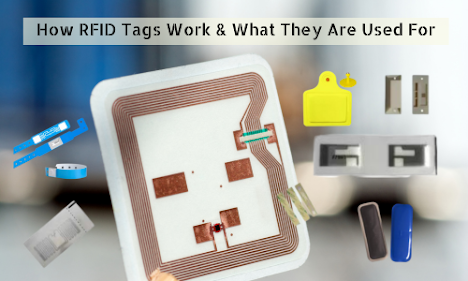Understanding RFID Tags: How RFID Tags Work and Their Uses
Introduction to RFID Tags
Radio Frequency Identification (RFID) tags are small devices that use radio waves to transmit data to an RFID reader. These tags are integral to RFID systems, which track and identify objects wirelessly. RFID tags are commonly used in various industries, including retail, healthcare, logistics, and more, to streamline operations, enhance security, and improve inventory management.
How RFID
Tags Work
RFID
systems comprise three main components: the RFID tag, the RFID reader, and the
antenna.
- RFID Tag: This small device contains a
microchip and an antenna. The microchip stores a unique identifier and other
data, while the antenna transmits this information to the RFID reader. RFID tags are
differentiated by their radio frequencies: low frequency (LF), high frequency
(HF), and ultra-high frequency (UHF).
LF
systems operate
within the 30-300 KHz range and can read up to 10 cm, commonly used for access
control and livestock monitoring.
HF
systems operate
within the 3 to 30 MHz range with a read range from 10 cm to 1 m (3 ft). They
are commonly utilized for electronic tickets, payments, or user experience
applications.
UHF systems operate within the 300 MHz to 3
GHz range and can read tags up to 12 meters (39 feet) away. These systems are
commonly utilized for retail inventory
tracking, parking garage management, door access, and asset tracking.
RFID tags
have three variations: passive, active, and semi-passive, each with distinct
advantages for specific applications.
Passive
Tags: These
tags are a type of RFID tag that operates without an internal power source.
Instead, they utilize the electromagnetic energy emitted by the RFID reader
to power the chip and enable the transmission of data. This means that they do
not require a battery or power source of their own to function, making them a
cost-effective and efficient option for various applications.
Active
Tags: These
have an internal battery and can transmit data over longer distances.
Semi-passive Tags: Similar to passive tags but with a battery to power the microchip, not the communication.
2. RFID Reader: The reader emits radio waves via its antenna, which interact with the RFID tag. The tag confidently transmits its stored information back to the reader.
3. Antenna: This component facilitates
communication between the tag and the reader. The type and size of the antenna
can vary depending on the required read range and application.
Applications
of RFID Tags
RFID technology is so
versatile, it's used in all kinds of industries. Here are some key
applications:
- Supply Chain and Inventory
Management
- RFID tags streamline the
tracking of goods through the supply chain, providing real-time data on
inventory levels. This reduces the risk of overstocking or stockouts,
optimizing the supply chain process and enhancing efficiency.
- Retail and Asset Tracking
- In retail, RFID tags are
used to prevent theft, manage inventory, and streamline checkout
processes. By tagging products, retailers can track items from the
warehouse to the sales floor, reducing losses and improving customer
satisfaction.
- Healthcare
- RFID technology is used for
patient identification, tracking medical equipment, and managing
pharmaceutical inventory. This ensures accurate patient records, reduces
errors, and improves the management of expensive medical assets.
- Access Control and Security
- RFID systems are widely
used in secure access applications, such as in offices, hotels, and event
venues. The technology provides a secure way to control access to
restricted areas, replacing traditional keys with RFID-enabled cards or
badges.
- Transportation and Logistics
- RFID tags are used in
vehicle identification systems, such as toll collection and vehicle
tracking. This technology helps in managing fleets, reducing congestion
at toll booths, and improving traffic flow.
- Agriculture and Livestock
Tracking
- In agriculture, RFID tags
are used to track livestock, monitor their health, and manage breeding
programs. This ensures better livestock management and helps in complying
with regulatory requirements.
Emerging
Trends in RFID Technology
As
technology evolves, so does the application of RFID. Innovations such as the
integration of RFID with the Internet of Things (IoT) are creating new
possibilities for real-time data collection and analysis. This integration
enhances decision-making processes, optimizes operations, and provides valuable
insights into consumer behavior and asset utilization.
Conclusion
RFID tags are a versatile and powerful
tool in modern data collection and asset tracking systems. Their ability to
transmit data wirelessly and their diverse applications make them essential in
many industries. As RFID technology continues to advance, its usage is likely
to expand, offering new possibilities for efficiency and innovation.




Comments
Post a Comment